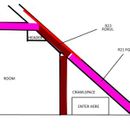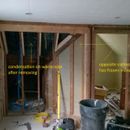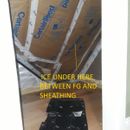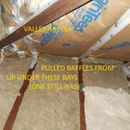Moisture in cathedral ceiling assembly
Hi. We have a 1951 brick cape which we have been renovating for several years. We have a small area in the valley of two gables that was turned into a small storage area between rooms. The area was previously very poorly insulated, so we had filled it with rock wool and in some cases, installed baffle vents (more on that below). Because we were tired of “improving” and didn’t want to fully demo the rooms, spray foam, etc, we tried to do the best we could with what was open.
I had posted some questions last year, more or less after it was too late, and was advised that putting in the baffles in an area with no soffit was useless. This year I decided to better seal the area to keep any cold air from coming into the room from the storage area ahead of building a door for it. Figuring the baffles were just letting cold air into the area from the attic, I pulled one out, and was horrified to find condensation on the warm side (between the baffle and the rock wool). I decided to dig around other areas , especially where I had just applied FB batts, and found a light coating of frozen ice pretty much everywhere. Merry Christmas!
So now I have to figure out what to do (besides maybe scrap this whole idea of a conditioned storage area lol. Was I better off having the baffles in there, as at least the water was condensing on the baffle and not the sheathing? I understand the RIGHT way would be to pull it all down and spray foam or cut & cobble (I have read all the blogs) but it’s a little too late for that now as the rooms are finished. I suppose I could decide to gut the area fully and do the full treatment in a few years, but doing so now would be extremely disruptive (not to mention divorce inducing :P)
So I guess one more question is, is it typical for cathedral ceilings to get SOME condensation that just dries naturally? One thing that I can’t quite fathom is that for 60 years this same area was insulated in more or less the same way (admittedly not very well) with Balsam Wool. Unless it allowed THAT much more airflow between the insulation and sheathing, I can’t believe this is the first time that this has taken place. The sheathing in this area is 50’s era T&G 3/4″ planks, and I can’t see any evidence of mold or rot at all.
Sincere thanks as always for any advice!
GBA Detail Library
A collection of one thousand construction details organized by climate and house part













Replies
G.S.,
If I understand you correctly, here's what you did: You tried to use an insulation method that only works for vented assemblies -- that is, assemblies that have soffit vents and ridge vents, with a clear path all the way from the soffit vent to the ridge vent -- and you applied that insulation method in rafter bays that, for all intents and purposes, aren't vented.
Moreover, it looks like you failed to install an interior air barrier -- that is, an air barrier on the interior side of the insulation. (Usually, taped drywall fills this purpose.)
What appears to have happened is that warm, moist interior air found its way through air leaks in the ceiling assembly, and the moisture in the interior air condensed on the first cold surface.
As is explained in my article, How to Build an Insulated Cathedral Ceiling, this type of roof assembly must be insulated using methods appropriate for an unvented assembly. If you are working from the interior side of the sheathing, that means that you need to install closed-cell spray foam on the underside of the roof sheathing.
Thanks Martin...
You are more or less correct, but I am guessing that the warmer moister air is coming in from a very obvious path - via that door-less opening.
If I tried to completely air seal the area with some poly, and of course the air seal the small door, which I planned to do anyway.. would that help the situation at all? Having an open door space there surely is allowing air into the storage space, and there are numerous gaps where surfaces meet that are not fully air-sealed. Air will still get in there from other places (the attic, the minimal soffit), but hopefully it won't be warmer humid air.
I would like to fix it properly at some point, but for now I would like to minimize the impact as much as possible.
G.S.,
Anything short of the methods I advocate in my article ("How to Build an Insulated Cathedral Ceiling") is risky. You should rip out all the fluffy insulation and install closed-cell spray foam.
If you don't want to do that, you risk moisture accumulation and rot.
Adding a door does not provide the needed air barrier. The needed air barrier must be installed on the interior side of the insulation, in direct contact with the insulation. But even if you install the missing air barrier, your method of installation is still flawed and therefore risky.